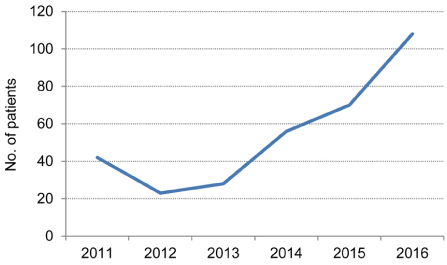J Dent Anesth Pain Med.
2016 Sep;16(3):203-208. 10.17245/jdapm.2016.16.3.203.
A survey of dental treatment under general anesthesia in a Korean university hospital pediatric dental clinic
- Affiliations
-
- 1Department of Pediatric Department, School of Dentistry, Dankook University, Cheonan, Korea. jbkim0222@dankook.ac.kr
- 2Department of Anesthesiology, School of Dentistry, Dankook University, Cheonan, Korea.
- KMID: 2354656
- DOI: http://doi.org/10.17245/jdapm.2016.16.3.203
Abstract
- BACKGROUND
In South Korea, the number of cases of dental treatment for the disabled is gradually increasing, primarily at regional dental clinics for the disabled. This study investigated pediatric patients at a treatment clinic for the disabled within a university hospital who received dental treatment under general anesthesia. This data could assist those that provide dental treatment for the disabled and guide future treatment directions and new policies.
METHODS
This study was a retrospective analysis of 263 cases in which patients received dental treatment under general anesthesia from January 2011 to May 2016. The variables examined were gender, age, reason for anesthesia, type of disability, time under anesthesia, duration of treatment, type of procedure, treatment details, and annual trends in the use of general anesthesia.
RESULTS
Among pediatric patients with disabilities who received dental treatment under general anesthesia, the most prevalent age group was 5-8 years old (124 patients, 47.1%), and the primary reason for administering anesthesia was dental anxiety or phobia. The mean time under anesthesia was 132.7 ± 77.6 min, and the mean duration of treatment was 101.9 ± 71.2 min. The most common type of treatment was restoration, accounting for 158 of the 380 treatments performed.
CONCLUSIONS
Due to increasing demand, the number of cases of dental treatment performed under general anesthesia is expected to continue increasing, and it can be a useful method of treatment in patients with dental anxiety or phobia.
MeSH Terms
Figure
Cited by 1 articles
-
Effects site concentrations of propofol using target-controlled infusion in dental treatment under deep sedation among different intellectual disability types
Keyling S. Salinas Salmeron, Hyun Jeong Kim, Kwang-Suk Seo
J Dent Anesth Pain Med. 2019;19(4):217-226. doi: 10.17245/jdapm.2019.19.4.217.
Reference
-
1. Korean Academy of Pediatric dentistry. Pediatric dentistry. 5th ed. Seoul: Dental Wisdom;2014. p. 817–827.
Article2. Solomon A. Indications for dental anesthesia. Dent Clin North Am. 1987; 31:75–80.
Article3. Kim SO. A survey of general anesthesia, sevoflurane sedation and intravenous sedation in chungnam dental clinic for the disabled. J Korean Acad Pediatr Dent. 2013; 40:28–39.
Article4. Kwak HJ, Kim JY, Kwak YL, Park WS, Lee KC. Comparison of a bolus of fentanyl with an infusion of alfentanil during target-controlled propofol infusion in third molar extraction under conscious sedation. J Oral Maxillofac Surg. 2006; 64:1577–1582.
Article5. Kum JE, Noh HS, Kim JM, Jeong TS. A survey of general anesthesia in pediatric dental clinic at Pusan national university. J Korean Dis Oral Health. 2007; 3:11–16.6. Whitwam J. Co-induction of anaesthesia: day-case surgery. Eur J Anaesthesiol Suppl. 1995; 12:25–34.7. Christiansen E, Chambers N. Induction of anesthesia in a combative child; management and issues. Pediatric Anesthesia. 2005; 15:421–425.8. Choi YK, Lee SM, Kim DO. A stastical analysis of the general anesthesia for dental treatment to children with developmental disability. J Korean Dent Soc Anesthesiol. 2002; 2:101–106.9. Choi SY, Kong EK, Baek KW. A Survey of Dental Treatment under General Anesthesia in Division of Pediatric Dentistry, Ajou University Hospital. J Korean Dent Soc Anesthesiol. 2014; 14:205–211.
Article10. Anderson HK, Drummond BK, Thomson WM. Changes in aspects of children's oral-health-related quality of life following dental treatment under general anaesthesia. Int J Paediatr Dent. 2004; 14:317–325.
Article11. Lee DW, Song JS, Choi HJ, Kang JW, Lee JH. A survey of dental treatment under outpatient general anesthesia in department of pediatric dentistry and clinic for disabled at Yonsei university dental hospital. J Korean Acad Pediatr Dent. 2010; 37:65–72.
Article12. Lee JH, Shon HK, Kim JH. A study on the treatment of dentally handicapped patients under outpatient general anesthesia. J Korean Acad Pediatr Dent. 1997; 24:581–589.
Article13. Seo KS, Jang KT, Kim HJ, Yum KW. The status of comprehensive dental treatment and type of disabilities of the patients treated under outpatient general anesthesia at the clinic for the disabled in Seoul national university dental hospital. J Korean Dent Soc Anesthesiol. 2006; 6:82–88.14. Jo DH, Yum KW. An Evaluation of Pediatric Oral and Maxillofacial Surgical Patients in Dental Hospital of Seoul National University. Korean J Anesthesiol. 1995; 29:84–87.15. Park CJ, Jung JM, Kim HJ. Analysis on the outpatient anesthesia at dental clinic for disabled in Seoul national university dental hospital. J Korean Acad Pediatr Dent. 2004; 31:19–25.16. Bak SH, Lee NY, Lee SH. A survey of dental treatment under general anesthesia. J Korean Dis Oral Health. 2008; 4:1–6.
- Full Text Links
- Actions
-
Cited
- CITED
-
- Close
- Share
- Similar articles
-
- A Survey of the Outpatient General Anesthesia and Dental Treatment in Chungnam Dental Clinic for the Disabled
- A Survey of the Sedation or Outpatient General Anesthesia in Department of Pediatric Dentistry, Chonnam National University Dental Hospital and Gwangju Dental Clinic for the Disabled
- The use of general anesthesia to facilitate dental treatment in adult patients with special needs
- Survey of the sevoflurane sedation status in one provincial dental clinic center for the disabled
- A Survey of Dental Treatment under General Anesthesia in Division of Pediatric Dentistry, Ajou University Hospital


